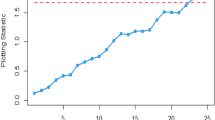Abstract
Concepts of Expected Waiting Time (EWT) and Expected Number of Exceedances (ENE) have been presented in much literature for estimating the Design Flood (DF) under non-stationary conditions. The parameters of the EWT and ENE are generally no less than four, which inevitably leads to the uncertainty of the DF estimation. In this paper, the Bayesian method is proposed to analyze the impact of parameter estimation uncertainty on the EWT- and ENE-based estimation of the DF and Corresponding Design Reliability (CDR). In addition, a comparison analysis between the EWT and ENE is conducted in terms of the DF and CDR with or without a consideration being given to the impact of parameter uncertainty. In the case of giving no consideration to the impact of parameter uncertainty, the experiment results indicate that the EWT-based estimations are less than that of ENE in terms of DF and CDR in the case of a decreasing trend. While in the case of an increasing trend, the EWT-based estimations are bigger than that of ENE. In the case of considering the impact of parameter uncertainty, results in the case study show that the distribution of the EWT-based estimations of DF and CDR are left shifted compared to that of the ENE. Overall, the EWT-based estimations are significantly different from that of ENE in terms of DF and CDR. Therefore, it is necessary and open for further discussions about which metric will be optimal between the EWT and ENE for estimating the DF under non-stationarity.











Similar content being viewed by others
References
Allamano P, Claps P, Laio F (2009) Global warming increases flood risk in mountainous areas. Geophys Res Lett 36(24):1–5
Burn DH (2008) Climatic influences on streamflow timing in the headwaters of the Mackenzie River Basin. J Hydrol 352:225–238
Cooley D (2013) Return periods and return levels under climate change. In: Agha Kouchak A et al (eds) Extremes in a changing climate: detection, analysis and uncertainty. Springer, Dordrecht
Du T, Xiong LH, Xu CY, Gippel CJ, Guo SL, Liu P (2015) Return period and risk analysis of nonstationary low-flow series under climate change. J Hydrol 527:234–250
Gelman A, Shirley K (2011) Inference from simulations and monitoring convergence. In: Brooks S, Gelman A, Jones G, Meng X (eds) Handbook of Markov chain Monte Carlo. Chapman & Hall/CRC, Boca Raton, pp 163–174
Gilroy KL, McCuen RH (2012) A nonstationary flood frequency analysis method to adjust for future climate change and urbanization. J Hydrol 414–415(1):40–48
Hosking J, Wallis J (1997) Regional Frequency Analysis. Cambridge University Press, Cambridge
Katz RW, Parlang MB, Naveau P (2002) Statistics of extremes in hydrology. Adv Water Resour 25(8):1287–1304
Liang Z, Chang W, Li B (2012) Bayesian flood frequency analysis in the light of model and parameter uncertainties. Stoch Environ Res Risk Assess 26:721–730
Liang Z, Hu Y, Li B, Yu Z (2014) A modified weighted function method for parameter estimation of Pearson type three distribution. Water Resour Res 50:3216–3228
Liu DD, Guo SL, Lian YQ, Xiong LH, Chen XH (2015) Climate-informed lowflow frequency analysis using nonstationary modelling. Hydrol Process 29(9):2112–2124
López J, Francés F (2013) Non-stationary flood frequency analysis in continental Spanish rivers using climate and reservoir indices as external covariates. Hydrol Earth Syst Sci 17:3189–3203
Massey FJ (1951) The Kolmogorov–Smirnov test for goodness of fit. J Am Stat Assoc 46(253):68–78
Milly PCD, Wetherald RT, Dunne KA, Delworth TL (2002) Increasing risk of great floods in a changing climate. Nature 415:514–517
Milly PCD, Betancourt J, Falkenmark M, Hirsch RM, Kundzewicz ZW, Lettenmaier DP, Stouffer RJ (2008) Stationarity is dead: whiter water management? Science 319(5863):573–574
Olsen JR, Lambert JH, Haimes YY (1998) Risk of extreme events under nonstationary conditions. Risk Anal 18(4):497–510
Parey S, Malek F, Laurent C, Dacunha-Castelle D (2007) Trends and climate evolution: statistical approach for very high temperatures in France. Clim Change 81(3–4):331–352
Parey S, Hoang T, Dacunha-Castelle D (2010) Different ways to compute temperature return levels in the climate change context. Environmetrics 21:698–718
Read LK, Vogel RM (2015) Reliability, return periods, and risk under nonstationarity. Water Resour Res 51(8):6381–6398
Salas JD, Obeysekera J (2014) Revisiting the concepts of return period and risk for non-stationary hydrologic extreme events. J Hydrol Eng 19:554–568
Singh VP, Wang SX, Zhang L (2005) Frequency analysis of nonidentically distributed hydrologic flood data. J Hydrol 307(1):175–195
Strupczewski WG, Singh VP, Mitosek HT (2001) Nonstationary approach to at-site flood frequency modeling III. Flood frequency analysis of Polish rivers. J Hydrol 248(1):152–167
Underwood FM (2009) Describing long-term trends in precipitation using generalized additive models. J Hydrol 364(3):285–297
Venables WN, Ripley BD (2002) Modern applied statistics with S, 4th edn. Springer, New York
Villarini G, Smith JA, Serinaldi F, Bales J, Bates PD, Krajewski WF (2009) Flood frequency analysis for nonstationary annual peak records in an urban drainage basin. Adv Water Resour 32(8):1255–1266
Wigley TML (1988) The effect of climate change on the frequency of absolute extreme events. Clim Monit 17(1–2):44–55
Yang Y, Tian F (2009) Abrupt change of runoff and its major driving factors in Haihe River Catchment, China. J Hydrol 374(3):373–383
Zhang X, Harvey KD, Hogg WD, Yuzyk TR (2001) Trends in Canadian streamflow. Water Resour Res 37(4):987–998
Acknowledgements
This study was supported by the Major Program of National Natural Science Foundation of China (51190095), the National Natural Key Technology R&D program of the ministry of Science and Technology of China (2013BAB06B01), and the Special Funds for Public Industry Research Projects of the China Ministry of Water Resources (201301066, 201401034). We are also grateful to all anonymous reviewers for their helpful comments, which helped us to improve the quality of the article.
Author information
Authors and Affiliations
Corresponding author
Rights and permissions
About this article
Cite this article
Hu, Y., Liang, Z., Chen, X. et al. Estimation of design flood using EWT and ENE metrics and uncertainty analysis under non-stationary conditions. Stoch Environ Res Risk Assess 31, 2617–2626 (2017). https://doi.org/10.1007/s00477-017-1404-1
Published:
Issue Date:
DOI: https://doi.org/10.1007/s00477-017-1404-1




